Ultrafast Fiber Optic Photodetector Modules, OEM Package

- Nine Models Cover Wavelengths from 700 nm to 1650 nm
- High-Fidelity Impulse Responses Down to 11 ps FWHM
- Bandwidths from 12 GHz to 50 GHz
- High-Power 25 GHz Model for Up to 100 mW (20 dBm)
DX50AF
SM, 50 GHz,
1250 - 1650 nm
DX25HA
SM, 25 GHz,
980 - 1625 nm,
Input ≤100 mW
DX30BF
MM, 30 GHz,
750 - 1650 nm
Compact, Hermetically Sealed Package for OEM Applications

Please Wait

Click to Enlarge
Figure 1.1 While each DX Series model is designed and intended for operation over the specified wavelength range shown by the solid colored regions above, each will respond with reduced performance to optical inputs at shorter wavelengths, as shown by the partially transparent regions. See the plots in the Graphs tab for details. Please contact Tech Support for more information.

Adam Knapp
Ultrafast Optoelectronics
General Manager
Got Questions?
Our engineers and expertise are here for you!
If you are not sure whether our catalog items meet your needs, we invite you to contact us. Or ask about a loan, so you can try them out for yourself, in your own lab. We can also support custom or OEM requirements you may have.
Just press the button, and we'll get back to you within the next business day.
Features
- Fiber-Coupled Detectors with Bandwidths Up to 50 GHz
- Compact Hermetic Modules for OEM Applications
- Visible, Near-Infrared, or Broadband Wavelength Ranges
- DC-Coupled Output
- Single Mode (SMF-28) and Multimode (OM4) Versions
- Available from Stock with FC/PC Connectors; Contact Tech Support for FC/APC Versions
- Discounts for High-Volume Purchases Available; Contact OEM Sales with Inquiries
- Available Packaged in Ultrafast Photodetector Instruments
Thorlabs' DX Series Ultrafast Fiber Optic Photodetector Modules provide high-fidelity optical detection with a clean impulse response as fast as 11 ps. Their compact hermetic packaging makes them ideal for OEM applications (see the Operation tab for details). They are available with single mode (Ø9 µm, SMF-28) or multimode (Ø50 µm, OM4) fiber pigtails, with options sensitive to a wide range of wavelengths, as shown in Figure 1.1.
The DXM Series Instruments offer these detectors within a rugged aluminum housing. Other features include a rechargeable battery with 500 mA·h capacity, current monitor circuitry, and a digital DC photocurrent display (click here for the full web presentation).
The performance of each DX series detector is factory tested and a test result summary is included with each detector shipped (sample). The test results and tabular data for detectors purchased after January 16th, 2020 can be downloaded by clicking on the red Docs icon (![]() ) next to the Item # and entering your device's serial number under "Download Serial Item Data." Please contact Tech Support if you would like to receive test results for devices purchased before January 16th, 2020.
) next to the Item # and entering your device's serial number under "Download Serial Item Data." Please contact Tech Support if you would like to receive test results for devices purchased before January 16th, 2020.
Thorlabs offers an enhanced calibration service for our DX Series photodetectors. This service includes a NIST-traceable S-parameter file with a frequency response up to 40 GHz at 850 nm, and up to 70 GHz at 1310 and 1550 nm. Please contact Tech Support for details.
These detectors use FC/PC connectors by default, but FC/APC connectors are available upon request; please contact Tech Support with inquiries. The RF signal outputs via a female 1.85 mm connector (Item # DX50AF) or an SMA-compatible 2.92 mm RF connector (all other detectors), which may be connected to an external instrument using suitable microwave cables or adapters.
Ideally, these items should be mounted to a printed circuit board (PCB) that supplies an electrical bias free of noise and spikes. An internal biasing network eliminates the need for an external bias tee. The output is designed for a 50-Ω coaxial cable and should be terminated into 50-Ω equipment to prevent electrical reflections. Because these detector modules are ESD sensitive, observe proper storage and handling procedures (see the Operation tab for details).
| Webpage Features | |
|---|---|
| Clicking this icon below opens a window that contains full specifications and performance graphs for each item. | |
| Clicking this icon below allows you to download our standard support documentation for each item. | |

Click to Enlarge
Typical Frequency Responses for the DX Series Ultrafast Detectors
Please see the blue info icons below (

Click to Enlarge
Typical Spectral Responses for the DX Series Ultrafast Detectors
Measured data is shown by the solid line, while theoretical data is shown by the dotted line. Please see the blue info icons below (

Click to Enlarge
Typical Impulse Responses for the DX Series Ultrafast Detectors
Please see the blue info icons below (

Click to Enlarge
Typical Electrical Return Loss for the DX Series Ultrafast Detectors
Please see the blue info icons below (
| Table 3.2 Photodetector Connectors | ||
|---|---|---|
| Item # | Fiber Conn. | RF Conn. |
| DX12CF DX12DF |
FC/PC | 2.92 mm |
| DX21AF | ||
| DX25CF DX25DF |
||
| DX25HF | ||
| DX25HA | FC/APC | |
| DX30AF DX30BF |
FC/PC | |
| DX50AF | 1.85 mm | |
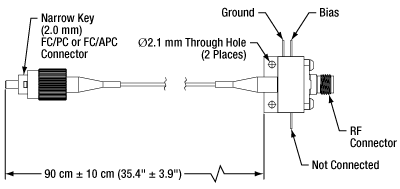 Click to Enlarge
Click to EnlargeFigure 3.1 Schematic of Pins and Connectors
Operation Guide
Please reference Table 3.2 and Figure 3.1 for connection options. Unpack the unit carefully, making sure to take ESD precautions.
- Mount the unit using the through hole mounting features.
- Connect the RF output of the unit to the measurement instrument using suitable cables or adapters. The measurement instrument must have a 50 Ω input and adequate bandwidth to resolve the high-speed signal from the ultrafast detector.
- Apply a 4 VDC voltage between the bias and ground pins.
- Couple the optical input signal to the detector via the fiber connector. Ensure the average input optical power does not exceed 10 dBm.
- The DC photocurrent can be monitored using a resistor in series with the bias pin and a voltmeter across the resistor. Make sure that the voltage drop across the resistor does not reduce the bias on the module below its operating voltage.

ESD Sensitive Components: Please note that the components inside the DX series units are ESD sensitive. Take all appropriate precautions to discharge personnel and equipment before making any electrical connections to the unit. This especially applies to coaxial connecting cables that can accumulate capacitive charge.

Adam Knapp
Ultrafast Optoelectronics
General Manager
Custom and OEM Options
When your application requirements are not met by our range of catalog products or their variety of user-configurable features, please contact me to discuss how we may serve your custom or OEM needs.
Request a Demo Unit
Explore the benefits of using a Thorlabs high-speed instrument in your setup and under your test conditions with a demo unit. Contact me for details.

Click to Enlarge
Figure 162A The MX40B Digital Reference Transmitter
Design, Manufacturing, and Testing Capabilities
Thorlabs' Ultrafast Optoelectronics Team designs, develops, and manufactures high-speed components and instrumentation for a variety of photonics applications having frequency responses up to 110 GHz. Our extensive experience in high-speed photonics is supported by core expertise in RF/microwave design, optics, fiber optics, optomechanical design, and mixed-signal electronics. As a division of Thorlabs, a company with deep vertical integration and a portfolio of over 20,000 products, we are able to provide and support a wide selection of equipment and continually expand our offerings.
Our catalog and custom products include a range of integrated fiber-optic transmitters, modulator drivers and controllers, detectors, receivers, pulsed lasers, variable optical attenuators, and a variety of accessories. Beyond these products, we welcome opportunities to design and produce custom and OEM products that fall within our range of capabilities and expertise. Some of our key capabilities are:
- Detector and Receiver Design, to 70 GHz
- Fiber-Optic Transmitter Design, to 110 GHz
- RF & Microwave Design and Simulation
- Design of Fiber-Optic and Photonics Sub-Assemblies
- High-Speed Testing, to 110 GHz
- Micro-Assembly and Wire Bonding
- Hermetic Sealing of Microwave Modules
- Fiber Splicing of Assemblies
- Custom Laser Engraving
- Qualification Testing
Overview of Custom and Catalog Products
Our catalog product line includes a range of integrated fiber-optic transmitters, modulator drivers and controllers, detectors, pulsed lasers, and accessories. In addition to these, we offer related items, such as receivers and customized catalog products. The following sections give an overview of our spectrum of custom and catalog products, from fully integrated instruments to component-level modules.
Fiber-Optic Instruments
To meet a range of requirements, our fiber-optic instruments span a variety integration levels. Each complete transmitter includes a tunable laser, a modulator with driver amplifier and bias controller, full control of optical output power, and an intuitive touchscreen interface. The tunable lasers, modulator drivers, and modulator bias controllers are also available separately. These instruments have full remote control capability and can be addressed using serial commands sent from a PC.
- Fiber-Optic Transmitters, to 110 GHz
- Linear and Digital Transmitters
- Electrical-to-Optical Converters, to 110 GHz
- Modulator Drivers
- Modulator Bias Controllers
- C- and L-Band Tunable Lasers
Customization options include internal laser sources, operating wavelength ranges, optical fiber types, and amplifier types.
Fiber-Optic Components
Our component-level, custom and catalog fiber-optic products take advantage of our module design and hermetic sealing capability. Products include detectors with frequency responses up to 50 GHz, and we also specialize in developing fiber-optic receivers, operating up to and beyond 40 GHz, for instrumentation markets. Closely related products include our amplifier modules, which we offer upon request, variable optical attenuators, microwave cables, and cable accessories.
- Hermetically-Sealed Detectors, to 50 GHz
- Fiber-Optic Receivers, to 40 GHz
- Amplifier Modules
- Electronic Variable Optical Attenuators
- Microwave Cables and Accessories
Customization options include single mode and multimode optical fiber options, where applicable, and detectors optimized for time or frequency domain operation.
Free-Space Instruments
Our free-space instruments include detectors with frequency responses around 1 GHz and pulsed lasers. Our pulsed lasers generate variable-width, nanosecond-duration pulses, and a range of models with different wavelengths and optical output powers are offered. User-adjustable repetition rates and trigger in/out signals provide additional flexibility, and electronic delay-line products enable experimental synchronization of multiple lasers. We can also adapt our pulsed laser catalog offerings to provide gain-switching capability for the generation of pulses in the 100 ps range.
- Pulsed Lasers with Fixed 10 ns Pulse Duration
- Pulsed Lasers with Variable Pulse Width and Repetition Rates
- Electronic Delay Units to Synchronize NPL Series Pulsed Lasers
- Amplified Detectors
Customization options for the pulsed lasers include emission wavelength, optical output powers, and sub-nanosecond pulse widths.
Pulsed Laser Emission: Power and Energy Calculations
Determining whether emission from a pulsed laser is compatible with a device or application can require referencing parameters that are not supplied by the laser's manufacturer. When this is the case, the necessary parameters can typically be calculated from the available information. Calculating peak pulse power, average power, pulse energy, and related parameters can be necessary to achieve desired outcomes including:
- Protecting biological samples from harm.
- Measuring the pulsed laser emission without damaging photodetectors and other sensors.
- Exciting fluorescence and non-linear effects in materials.
Pulsed laser radiation parameters are illustrated in Figure 170A and described in Table 170B. For quick reference, a list of equations is provided below. The document available for download provides this information, as well as an introduction to pulsed laser emission, an overview of relationships among the different parameters, and guidance for applying the calculations.
|
Equations: |
||||
 |
and |  |
||
 |
||||
 |
||||
 |
||||
Peak power and average power calculated from each other: |
||||
 |
and |  |
||
| Peak power calculated from average power and duty cycle*: | ||||
 |
*Duty cycle ( ) is the fraction of time during which there is laser pulse emission. ) is the fraction of time during which there is laser pulse emission. |
|||
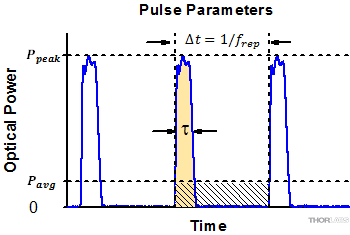
Click to Enlarge
Figure 170A Parameters used to describe pulsed laser emission are indicated in this plot and described in Table 170B. Pulse energy (E) is the shaded area under the pulse curve. Pulse energy is, equivalently, the area of the diagonally hashed region.
| Table 170B Pulse Parameters | |||||
|---|---|---|---|---|---|
| Parameter | Symbol | Units | Description | ||
| Pulse Energy | E | Joules [J] | A measure of one pulse's total emission, which is the only light emitted by the laser over the entire period. The pulse energy equals the shaded area, which is equivalent to the area covered by diagonal hash marks. | ||
| Period | Δt | Seconds [s] | The amount of time between the start of one pulse and the start of the next. | ||
| Average Power | Pavg | Watts [W] | The height on the optical power axis, if the energy emitted by the pulse were uniformly spread over the entire period. | ||
| Instantaneous Power | P | Watts [W] | The optical power at a single, specific point in time. | ||
| Peak Power | Ppeak | Watts [W] | The maximum instantaneous optical power output by the laser. | ||
| Pulse Width |  |
Seconds [s] | A measure of the time between the beginning and end of the pulse, typically based on the full width half maximum (FWHM) of the pulse shape. Also called pulse duration. | ||
| Repetition Rate | frep | Hertz [Hz] | The frequency with which pulses are emitted. Equal to the reciprocal of the period. | ||
Example Calculation:
Is it safe to use a detector with a specified maximum peak optical input power of 75 mW to measure the following pulsed laser emission?
- Average Power: 1 mW
- Repetition Rate: 85 MHz
- Pulse Width: 10 fs
The energy per pulse:

seems low, but the peak pulse power is:

It is not safe to use the detector to measure this pulsed laser emission, since the peak power of the pulses is >5 orders of magnitude higher than the detector's maximum peak optical input power.
| Posted Comments: | |
Jean-Michel Melkonian
(posted 2025-05-07 09:03:29.57) Dear Thorlabs,
what would you recommand to bias the photodiode? Would an alkalin 4.5V 3LR12 battery or a 4.5 V lithium battery pack do the trick? Or maybe by modifying the USB connector of a 5 V lithium battery? Too bad you don't offer a plug-ang-play solution.
Tx tdevkota
(posted 2025-05-12 12:53:08.0) Thank you for contacting Thorlabs. A battery or any high-quality laboratory-grade power supply should work fine. It would be unfair to recommend one specifically, as there are many good power supply options available. The main consideration is to avoid cheaper units that may produce voltage spikes when switching the supply on or off. For convenience and simplicity of use, we also offer instrument versions of these photodetector modules, which you can find here: www.thorlabs.com/newgrouppage9.cfm?objectgroup_id=10938#ad-image-0. These are the same photodetector modules mounted inside a rugged aluminum housing that includes a rechargeable battery, current monitor circuitry, and a digital display of the DC photocurrent. ruixiang guo
(posted 2024-03-01 17:50:55.217) I have purchased a DX20AF last year for measuring pulse width from fs laser.
I add the 4V bias and send a 200uw pulse laser (50MHz rep, 100fs pulse width), No output signal was observed.
Do you think this detector may be damaged? DO you offer repairing? jdelia
(posted 2025-11-04 01:01:10.0) Thank you for contacting Thorlabs. Please note that the pulse response is on the order of 10s of picoseconds. Inputting a pulse which is in the fs range will be faster than this device can interpret. Additionally, depending on whether 200 um refers to your average or peak power, you may have exceeded the max peak power of ~20 mW, thus damaging the device. We have reached out to you directly via email to discuss this further. user
(posted 2023-04-13 16:36:31.29) Hi, I have purchased a DX12CF last year to make a beatnote between two lasers.
Though, I have a hard time coupling (with decent efficiency) my 780 nm beams into a SMF-28 fiber.
Do you recommend a particular model of Fiber collimator/coupler to inject the DX12-CF fiber with 700-870 light ? cdolbashian
(posted 2023-04-26 09:24:32.0) Thank you for reaching out to us with this inquiry! Single mode fiber coupling is nontrivial in its execution, and will require extra care for excellent performance. I have reached out to you via email to expound on this fact as well as offer some more in-depth guidance on the topic of single mode fiber coupling. user
(posted 2022-04-25 17:20:45.773) By what method is the detector linearity calculation made? Also, is the saturation power limited by the load resistance and reverse bias at which the output voltage approaches the reverse bias voltage, or are other nonlinearities dominate? I imagine that if i'm using a TIA circuit that maintains a constant bias across the detector, other effects such as space charge effects and electrical nonlinearities could dominate. jdelia
(posted 2022-05-05 10:37:01.0) Thank you for contacting Thorlabs. Linearity for these units is tested using a very low duty cycle pulsed source. For saturation, this is correct for photodiodes. These effects are a combination of average pulse power and peak pulse power. At one extreme is the low duty cycle, high pulse power with a low duty pulse (the other extreme is for signals which are mostly CW). For low duty cycle pulses, saturation effects start around 500mV output. As long as you stay within the operating limits of the unit, you will not encounter local/temporal nonlinear effects due to the pulse peak powers saturating. If you operate with pulses beyond the bandwidth of the detector, this would not hold true however. We have contacted you directly to discuss your application further. firoz Khan
(posted 2019-09-30 15:04:40.11) Hello SIr,
I am Mohammad Firoz Khan doing my research in quantum optics. We have purchased DX30BF, DX20AF Ultrafast Fiber Optic Photodetector Modules from Thorlab. We are not able to employ this detector in our experiments. You have mentioned that 4 VDC voltage between the bias and ground pins. We have applied this biasing voltage and giving optical input on fiber port. Output is collected by the SMA port using a very high speed digital oscilloscope. We are not getting any output signal from detector. We are doing as you mentioned in data sheets. Is there any components we have missed here? Please sort out my problem and make this detector applicable for my experiments. YLohia
(posted 2019-10-22 02:27:43.0) Hello Firoz, thank you for contacting Thorlabs. We had reached out to you directly with troubleshooting steps at the time of your original post. If you have further questions regarding this issue, please feel free to reply to my email. |

| Item #a | Full Specs |
Fiber Pigtail | Bandwidth | Wavelength Range |
Impulse Response |
Responsivity | Conversion Gainb |
Optical Return Loss (Max) |
Noise-Equivalent Power (NEP)c |
Photodiode Bias Voltage |
|---|---|---|---|---|---|---|---|---|---|---|
| DX12CF | SMF-28d (SM) | DC - 12 GHz (at 780 nm) |
700 - 870 nm | 29 ps (FWHM at 780 nm) |
0.60 A/W | 15 V/W | -28 dB | 43 pW/√Hz | 4 V | |
| DX12DF | OM4e (MM) | 0.55 A/W | 14 V/W | -18 dB |

| Item #a | Full Specs |
Fiber Pigtail | Bandwidth | Wavelength Range |
Impulse Response |
Responsivity | Conversion Gainb |
Optical Return Loss (Max) |
Noise-Equivalent Power (NEP)c |
Photodiode Bias Voltage |
|---|---|---|---|---|---|---|---|---|---|---|
| DX25CF | SMF-28d (SM) | DC - 25 GHz (at 780 nm) |
700 - 870 nm | 19 ps (FWHM at 780 nm) |
0.5 A/W | 12.5 V/W | -25 dB | 51 pW/√Hz | 4 V | |
| DX25DF | OM4e (MM) | 0.45 A/W | 11.0 V/W | -18 dB |

- Linear Response Up to 100 mW (20 dBm) of Input Optical Power
- Available with an FC/PC or FC/APC Connector

| Item #a | Full Specs |
Fiber Pigtail | Bandwidth | Wavelength Range |
Impulse Response |
Responsivity | Conversion Gainb | Optical Return Loss (Max) |
Noise-Equivalent Power (NEP)c |
Photodiode Bias Voltage |
|---|---|---|---|---|---|---|---|---|---|---|
| DX30AF | SMF-28d (SM) | DC - 30 GHz (at 1560 nm) |
750 - 1650 nm | 15 ps (FWHM at 1560 nm) |
0.45 A/W (at 850 nm) 0.75 A/W (at 1550 nm) |
11.3 V/W (at 850 nm) 18.7 V/W (at 1550 nm) |
-14 dB (at 850 nm) -18 dB (at 1550 nm) |
32 pW/√Hz | 4 V | |
| DX30BF | OM4e (MM) | 0.42 A/W (at 850 nm) 0.7 A/W (at 1310 nm) |
10.5 V/W (at 850 nm) 17.5 V/W (at 1310 nm) |
-8 dB (at 850/1310 nm) |
 Products Home
Products Home




















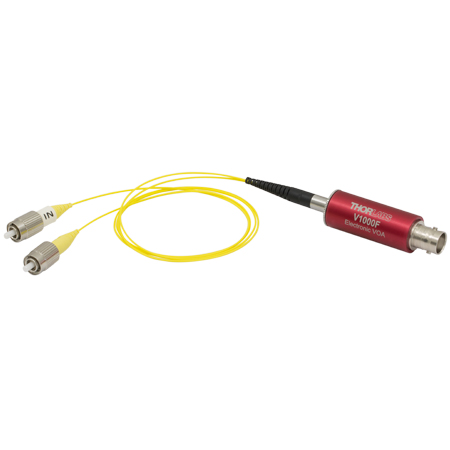


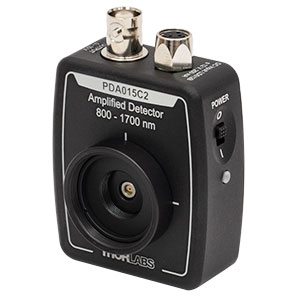



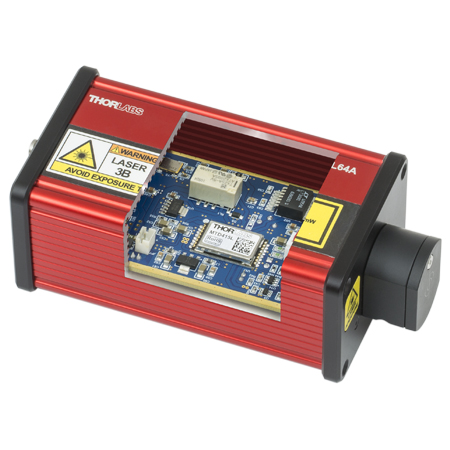


 Telecom-Grade Photodetectors for OEM
Telecom-Grade Photodetectors for OEM